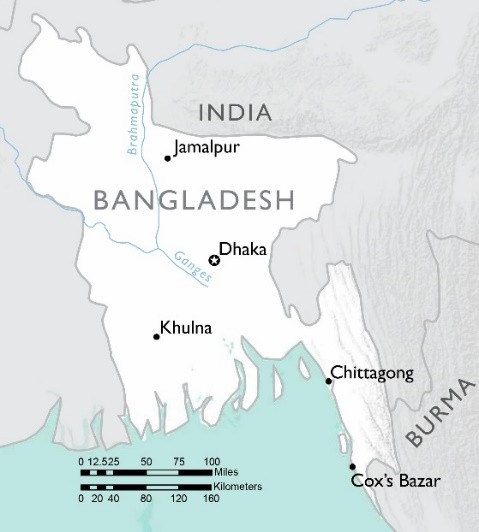- What We Do
- Agriculture and Food Security
- Democracy, Human Rights and Governance
- Economic Growth and Trade
- Education
- Ending Extreme Poverty
- Environment and Global Climate Change
- Gender Equality and Women's Empowerment
- Global Health
- Water and Sanitation
- Working in Crises and Conflict
- U.S. Global Development Lab
August 11, 2017
Food Security Situation

- More than 31 percent of Bangladeshis live below the national poverty line, according the UN World Food Program (WFP). Frequent natural disasters—including floods and cyclones—exacerbate issues caused by the high national poverty rate.
- In addition to natural disasters, the most socially vulnerable Bangladeshis have historically lacked access to health and hygiene services. These factors, along with relatively high domestic prices for rice, the staple food crop, heighten food insecurity, particularly amongst the rural poor. According to WFP, stunting affects 36 percent of children under 5. Additionally, 11 million people suffer from acute hunger.
- In recent years, Bangladesh has achieved signifcant development gains, including sustained economic growth, improved gender parity in education, and reduced child and maternal mortality. Despite this progress, 40 million people—approximately one-quarter of the population—remain food insecure.
- In October 2016, the Burmese Government performed a series of security operations targeting Rohingya Muslims in northern Burma. The ensuing violence has forced more than 80,000 Rohingya refugees to flee to southeastern Bangladesh, according to the UN. Most of these refugees currently reside in makeshift settlements near Cox’s Bazar, where they face exposure to natural disasters and food insecurity. As of June 2017, the UN reported a global acute malnutrition rate of more than 21 percent in one of the major refugee camps near Cox’s Bazar.
Food Assistance Response
- In Bangladesh, the Office of Food for Peace (FFP) partners with CARE International, Helen Keller International, and World Vision to implement multi-year development programs designed to promote agriculture, livelihoods, maternal and child health, climate change adaptation, women’s empowerment and disaster risk reduction and community resilience in multiple regions throughout the country. In Fiscal Year (FY) 2017, FFP has contributed more than $9.9 million to these non-governmental organization (NGO) partners in support of their programs.
- FFP also supports WFP in Bangladesh. In FY 2017, FFP has contributed $1 million to WFP to provide unconditional cash transfers to more than 34,000 Rohingya refugees from Burma in Cox’s Bazar.
Food for Peace Contributions
Total Contributions:
| U.S. Dollars | Metric Tons | |
|---|---|---|
| Fiscal Year 2017 | $10.9 million | 72,510 MT |
| Fiscal Year 2016 | $40.7 million | 90,020 MT |
| Fiscal Year 2015 | $37.9million | 75,090 MT |
Note: MT: Metric Ton; Food Security Situation information provided by CARE and U.N. World Food Program (WFP).
To read more about USAID Feed the Future initiatives in Bangladesh, follow this link.
To read how FFP and Feed the Future are partnering to scale-up aquaculture in Bangladesh, click on this link.
Country Specific Information
Other Resources
Smart Phones and a Web-Based Software Improve Program Monitoring
Monjuara is a Bangladeshi mother that wants the best for her children. Armed with new health, agriculture and nutrition practices she learned from USAID, Monjuara can continue to dream of a better life for her family and is paying it forward in her community. In Bangladesh, where over 60 million people survive on less than $1.25 per day, USAID is arming millions of parents like Monjuara with the skills to break the cycle of poverty.







Comment
Make a general inquiry or suggest an improvement.